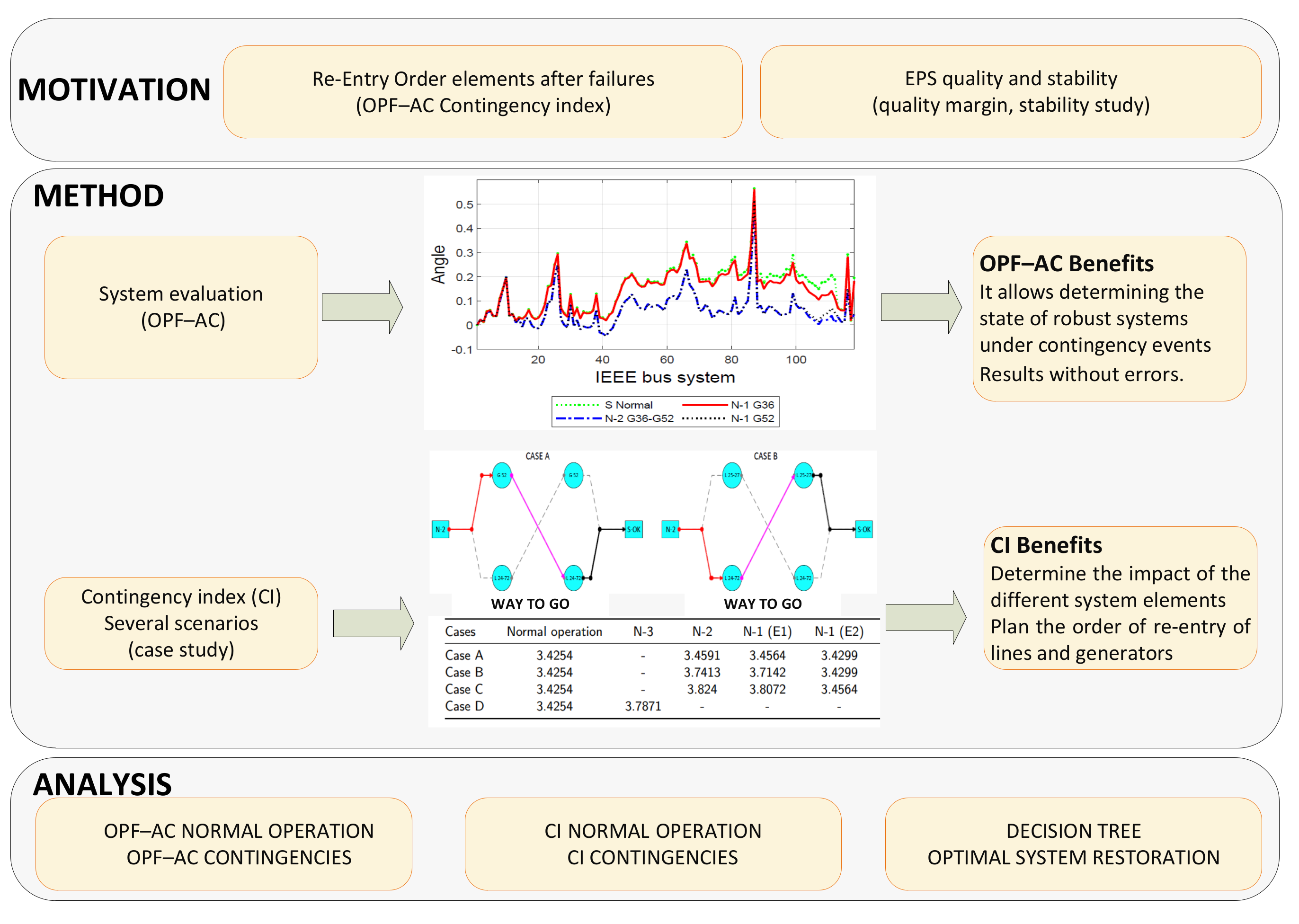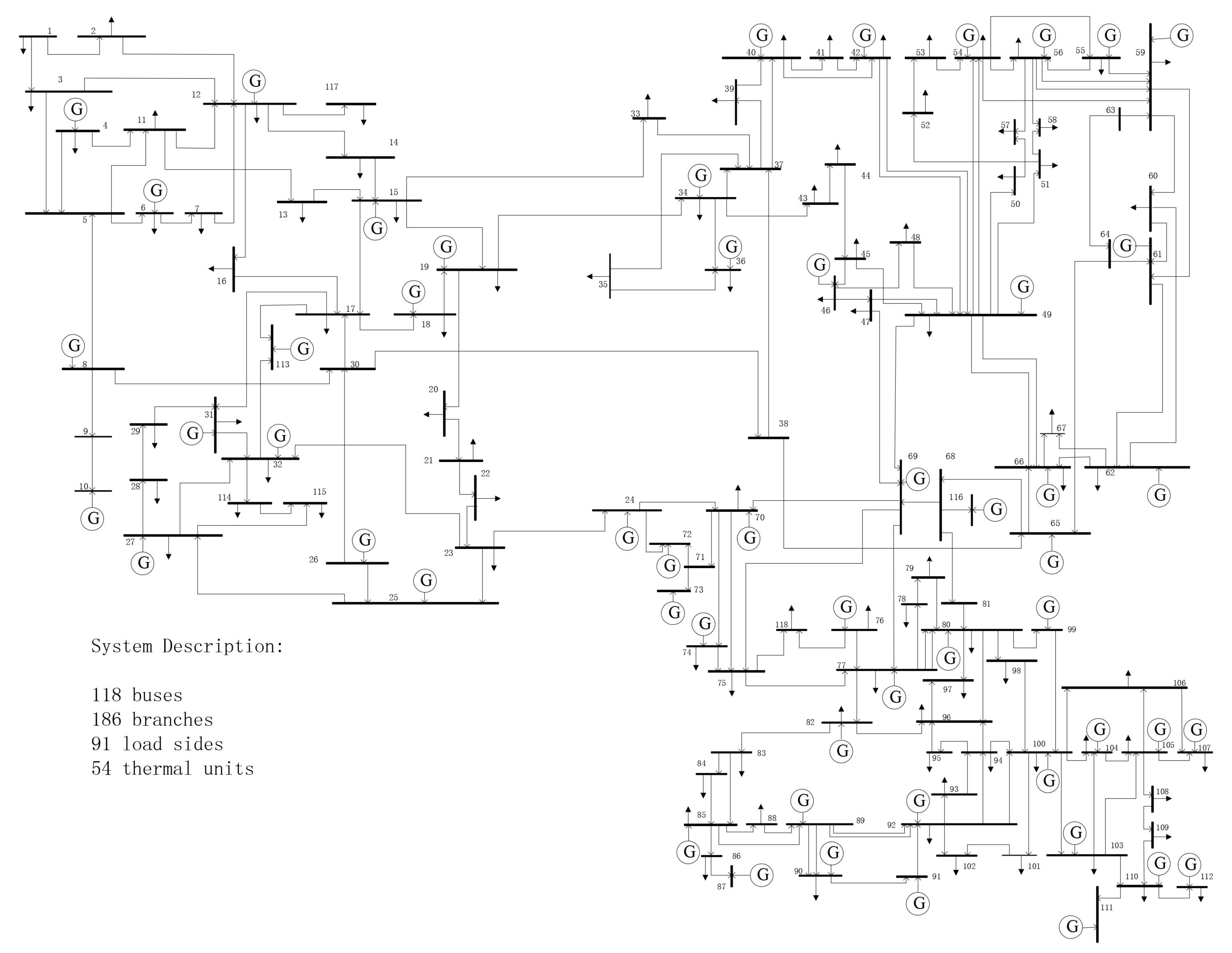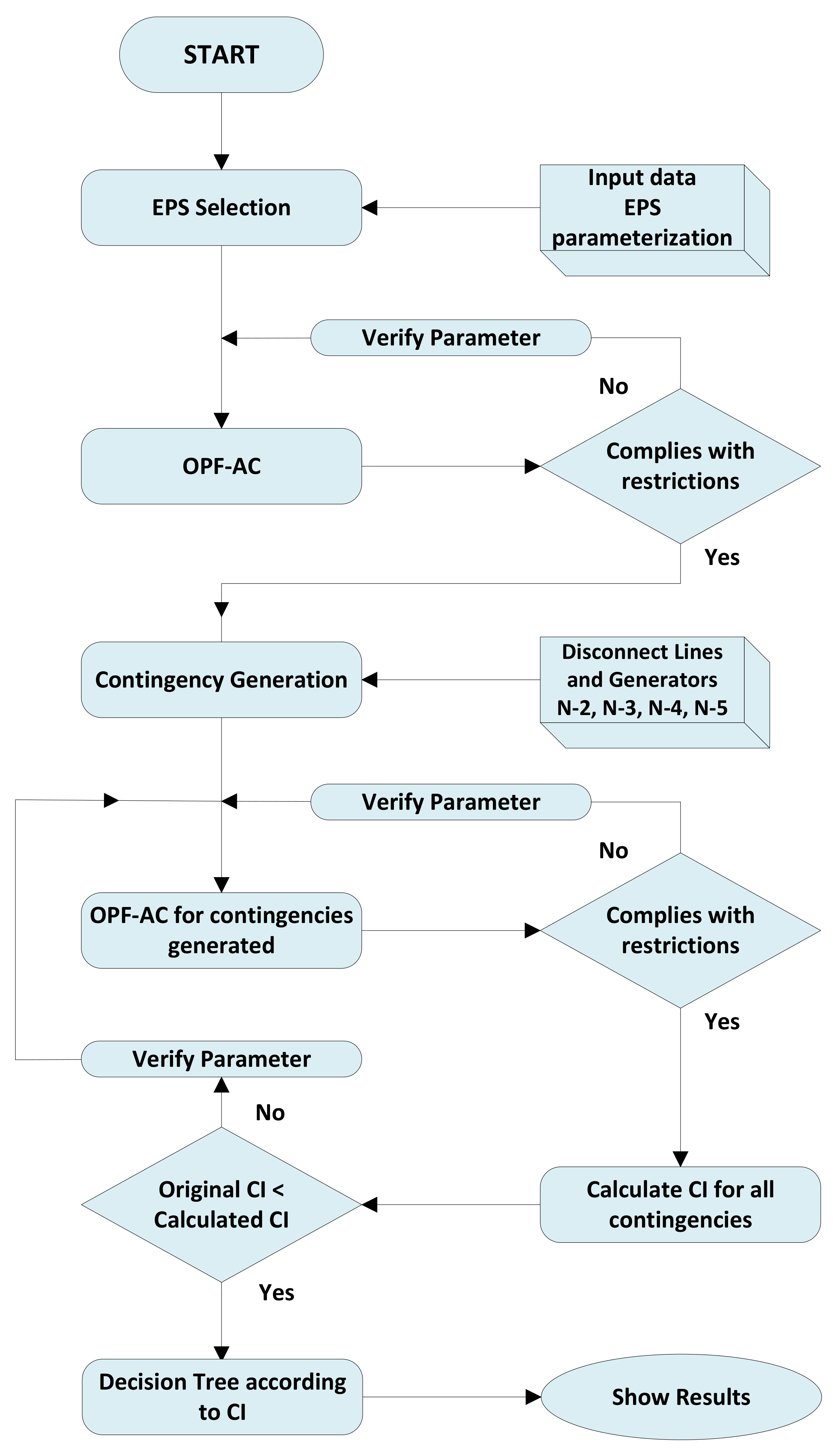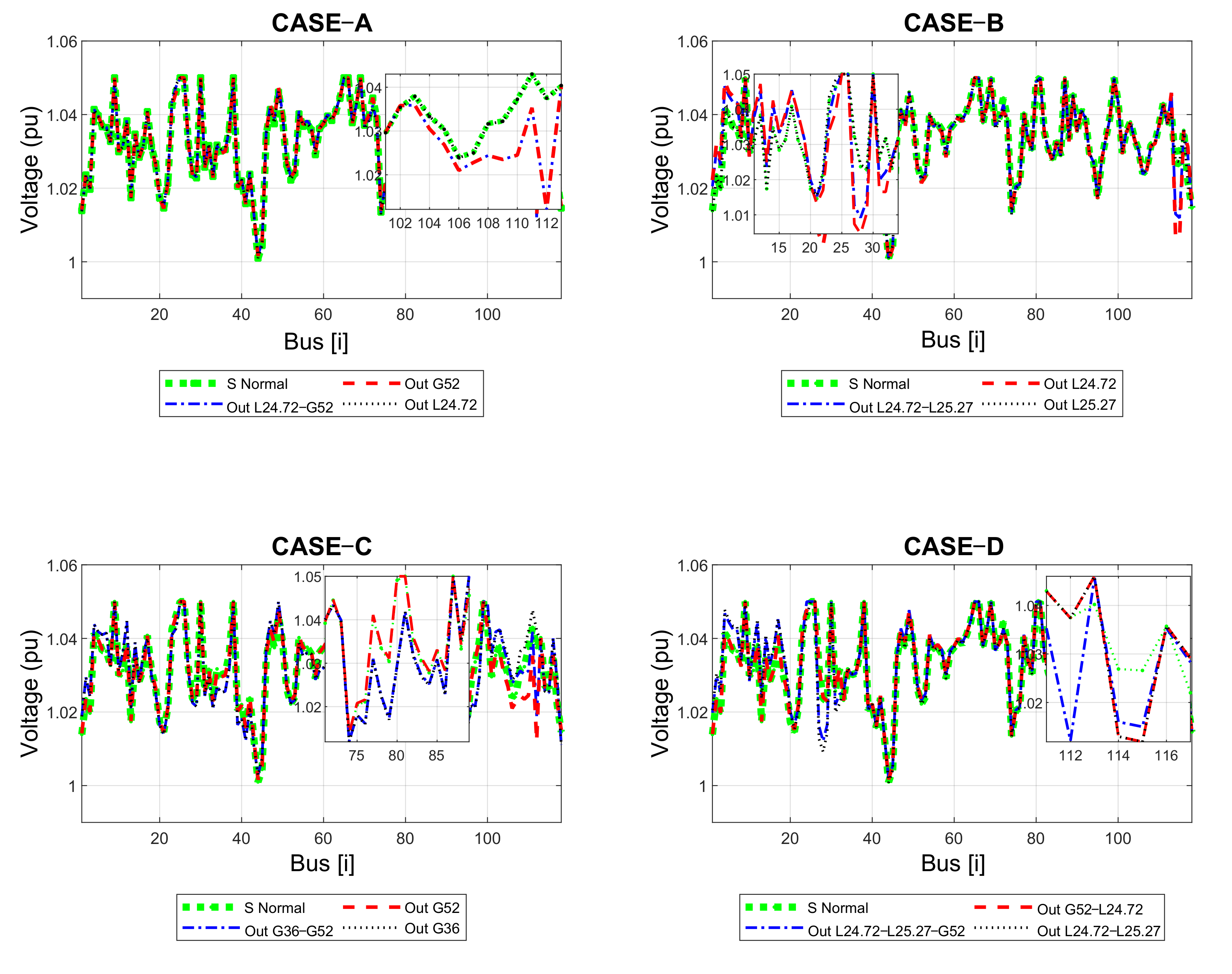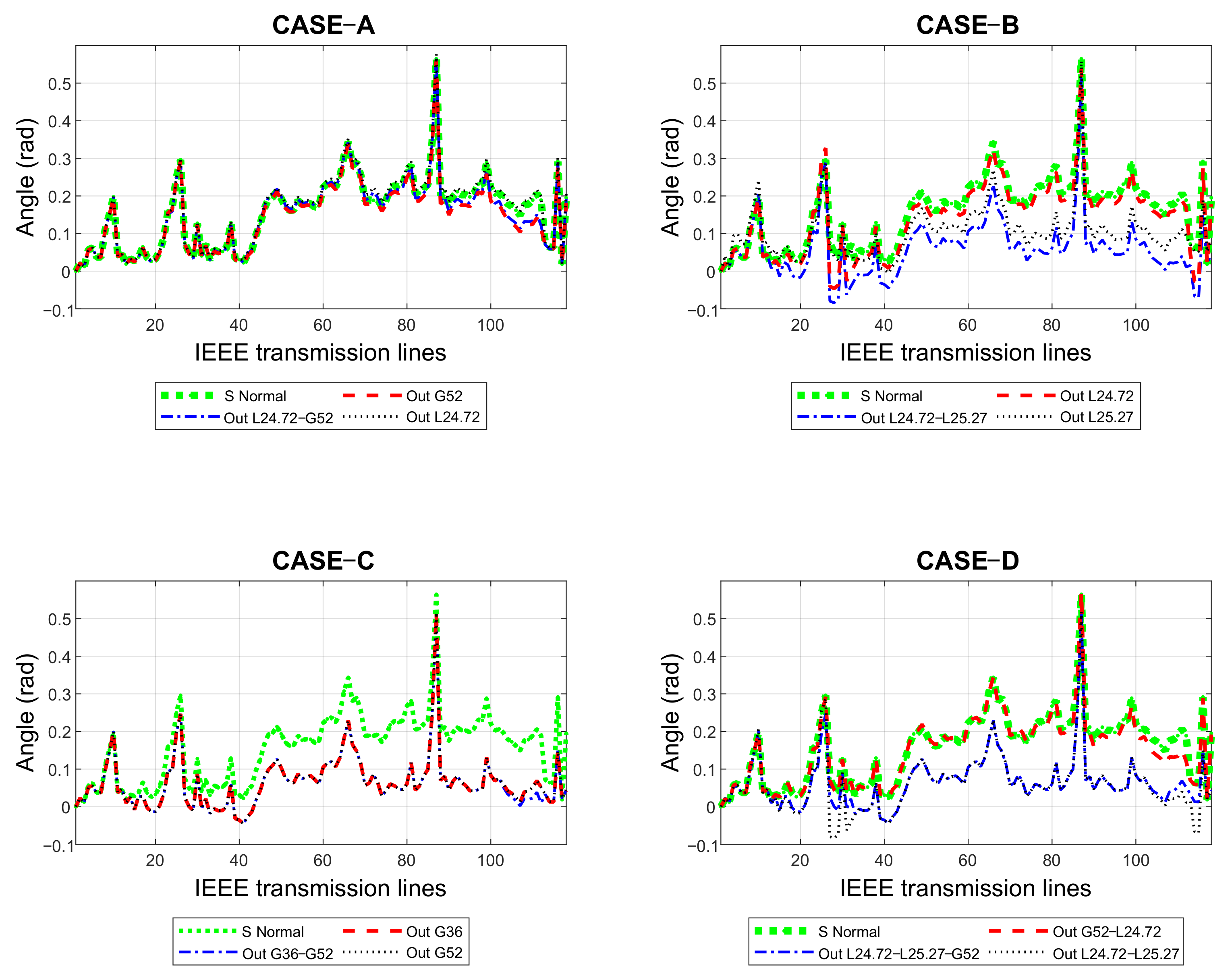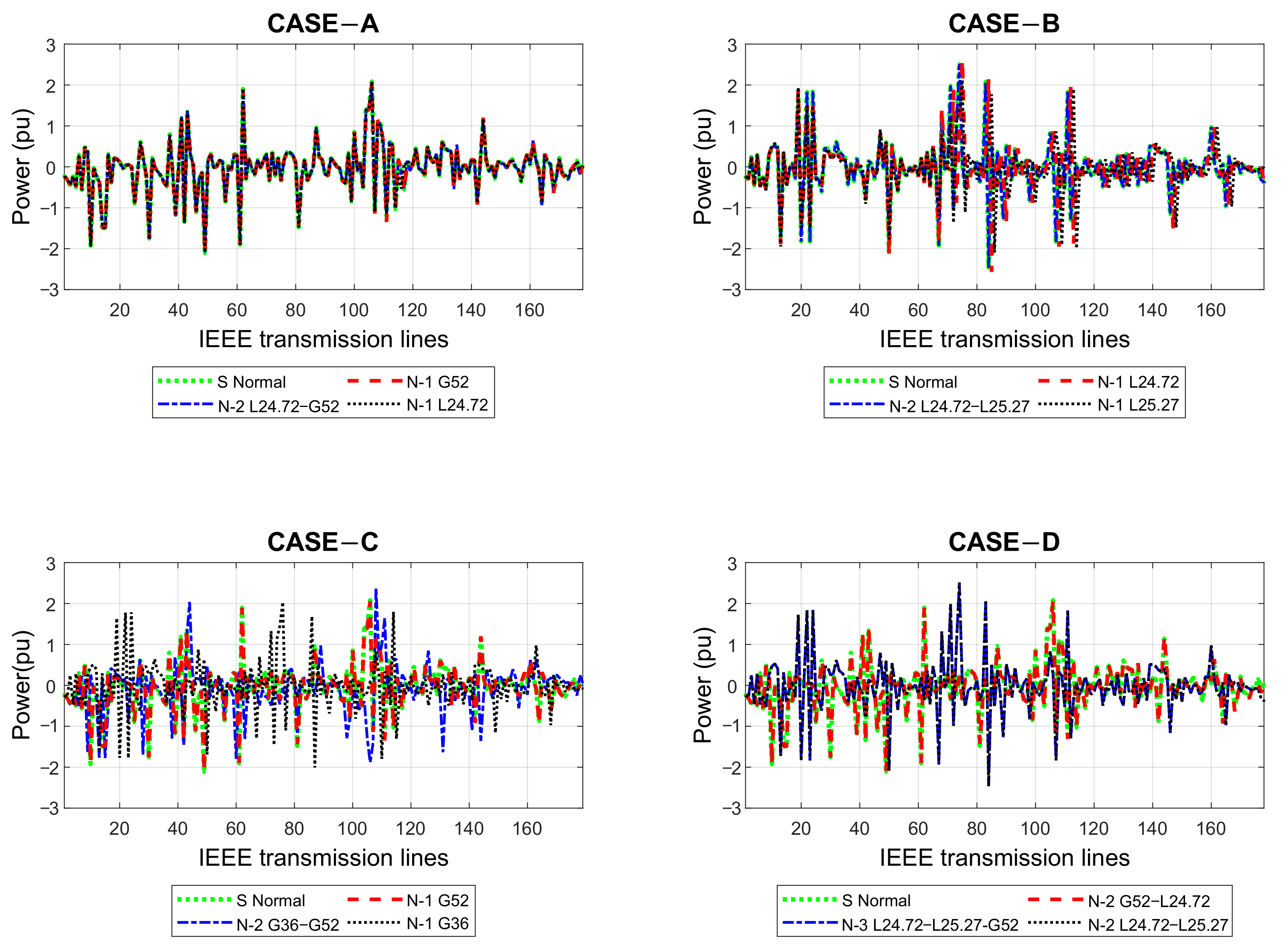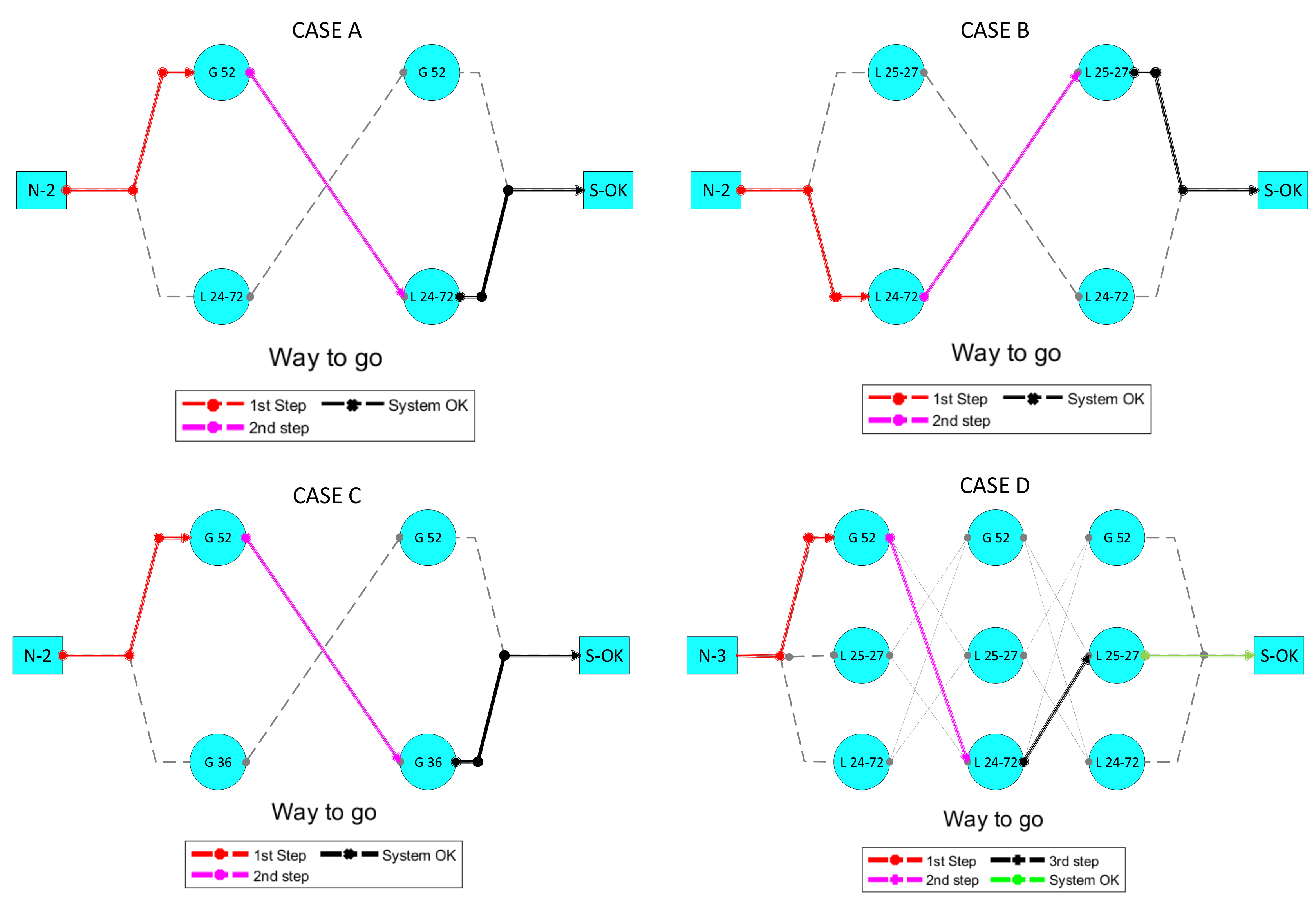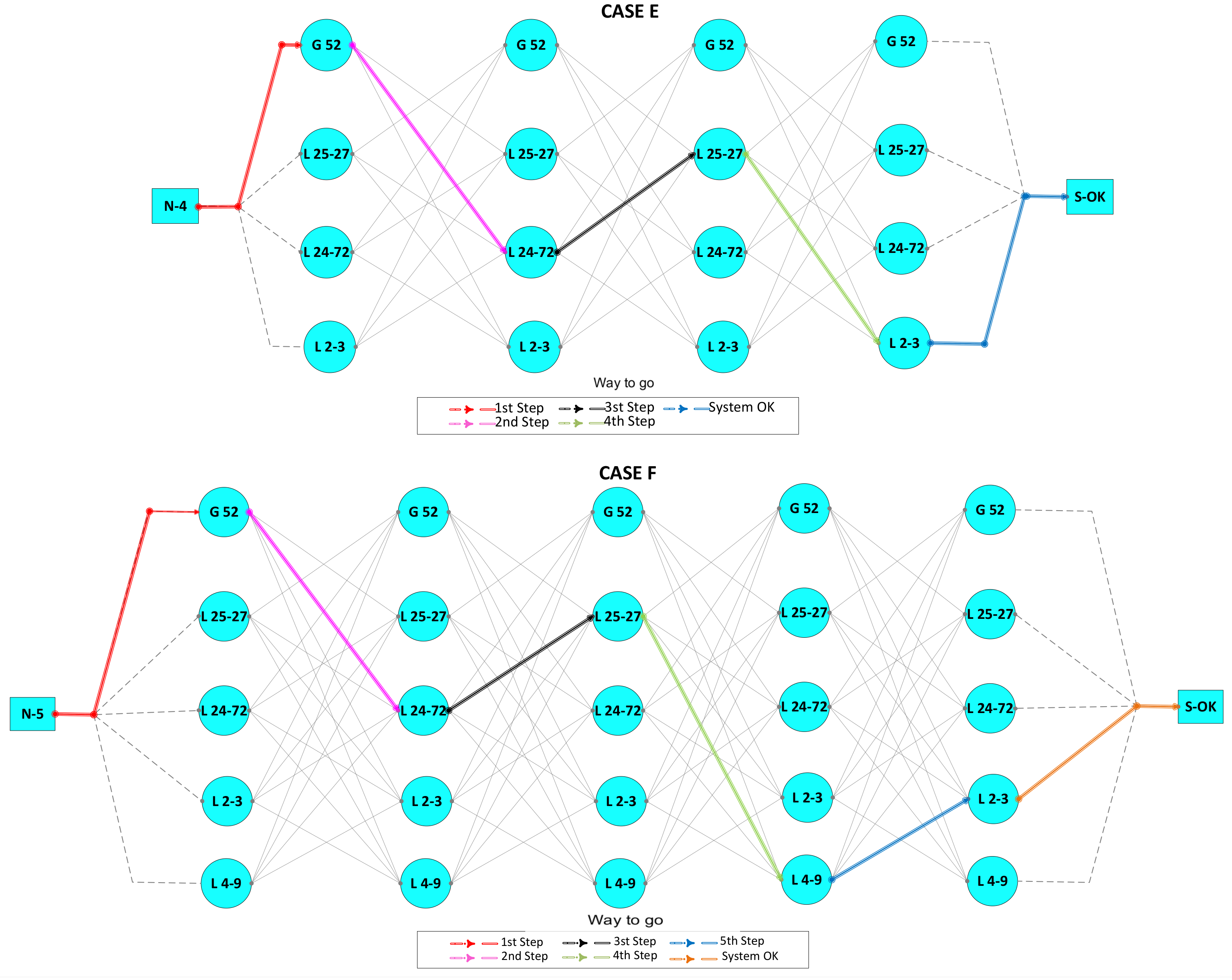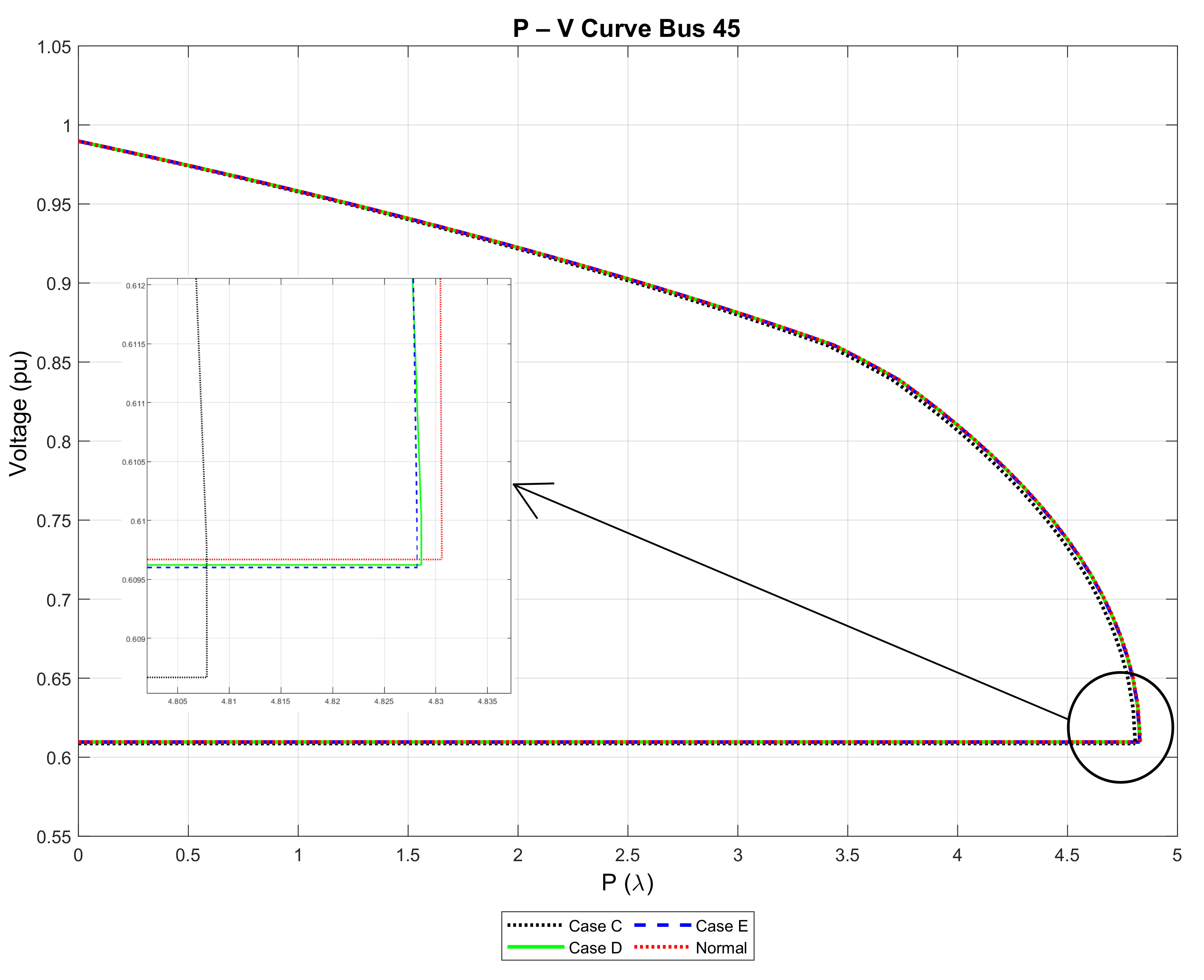1. Introduction
Nowadays, electrical power systems (EPS) are a fundamental part of the modern world since they are responsible for providing the electricity supply by supplying electricity for commercial, industrial, and residential users. The electrical systems are not exempt from failures; due to this, outages in the electrical service can be generated causing great economic losses. In addition, power outages affect a wide variety of institutions and departments, and among these, there are some considered of high importance: those that must have continuous electricity supply such as police, military and fire departments, hospitals, clinics, and health care centers. Therefore, it is of utmost importance that the restoration of the operation of the electrical power system is carried out in the shortest possible time, through maneuvers and corrective actions in a way that does not affect the continuity, quality, and stability of the electric power supply [
1,
2,
3].
There are factors that affect the EPS which cause it to stop supplying the electricity, such as connection and disconnection of loads and generation units, meteorological phenomena such as lightning, and bad maneuvering of EPS operators. The presence of these events generates disturbances in the electrical system causing oscillations, overvoltages, and overcurrents; in addition, it causes elements such as transmission lines, generators, and loads to be out of operation. The disconnection of transmission lines, generators, and loads can cause loss of stability in EPS and a disconnection cascade effect in most elements, which would lead to a partial or total blackout of the EPS [
2,
3,
4,
5].
Reestablishing the energy at the EPS goes beyond reconnecting generation units and transmission elements. Therefore, decision-making methodologies must be planned and determined, in addition to establishing steps so that the electrical system restoration complies with the quality and stability indexes. For the reason previously explained, it is necessary to take into account the following guidelines: know how the electrical power system is operating under normal conditions and under post-failure conditions, carry out a planning that ensures that the electrical system recovers its normal operation in the shortest possible time, determine the way for reconnection of the elements of the generation system, and the route for the entrance to the system of power transformers and transmission lines. The planning and methodology that will be determined and used for the restoration of the EPS should allow reducing generation costs caused by the power outages, in addition, to reduce the time used in the necessary maneuvers to reconnect the elements that went out of operation by evaluating technical criteria for the re-establishment of the normal operation of the EPS [
6,
7,
8].
Refs. [
9,
10] used the mixed integer linear programming (MILP) technique, which is used to determine the sequence in which the generators must enter. The authors also used the improved Dijkstra method, significantly reducing the time taken for the generators to start.
The authors of [
6] used various techniques for the restoration of EPS, dividing the problem into several stages: (i) using the MILP optimization technique, determining the input order of the generators, and (ii) using decision theory heuristics. This methodology has an interesting characteristic since it does not need to use technical variables such as voltage and current obtained from the EPS and its main objective is to ensure the generators reach their maximum power. Finally, for the restoration of the transmission system, a genetic algorithm is used.
The use of the water cycle algorithm (WCA) as a methodology to restore EPS is proposed in [
11], which takes into account various quality and reliability indexes to achieve the restoration of the EPS. This article considers the restoration of the transmission system. In addition, the results obtained from the WCA technique are compared with the particle swarm optimization heuristics (PSO) and the genetic algorithm (GA), where the water cycle algorithm methodology generates the optimal solution in less time than the PSO and the GA.
Contingency analysis allows studying the severity of elements disconnection in the power system; therefore, it is essential to consider its study. It is called contingency when one or more elements are disconnected from the electrical system unexpectedly due to unscheduled or unforeseen events such as wrong practices during maintenance of the electrical system. The operating outage of the following elements is considered a contingency: generators, loads, transmission lines, and transformers. To carry out the contingency analysis of the EPS, optimal power flows (OPF) are used to calculate variables such as current, voltage, frequency, and power. In this way, it is possible to know the post-contingency state of the EPS [
12,
13].
There are different methodologies that allow analyzing what happened in the EPS in the event of a failure or a contingency, for example, OPF-AC and optimal DC power flow (OPF-DC). Furthermore, in these types of problems, it is necessary to use OPF-AC and OPF-DC to determine the contingency indexes, which helps to determine which element of the EPS is most affected after a failure. These methodologies are used to determine generation dispatch cost and observe variables of voltage, angle, frequency, current, and technical losses through the power balance [
14,
15,
16,
17,
18].
State estimators (SE) allow the EPS to be monitored and are widely used by control centers to determine the state of the electrical power system. SE are useful to observe how the network is operating and contribute when it is the time of restoring the EPS since they allow to know the operating status of the EPS under normal conditions and in the event of failures or contingencies. The SE consist of sensors and meters placed throughout the electrical system, allowing it to process and interpret the operating variables of the EPS in real-time [
19,
20]. In [
21], a state estimator is presented which has as an objective to verify the post-contingency state when disconnecting a transmission line by generating contingencies N-1; this is performed through the transmission line outage post-contingency state estimator principle (PLOP).
In [
22], the authors propose a method to determine the state of the EPS after suffering the disconnection of transmission lines. The model is based on data obtained by the phasor measurement units (PMU) in pre-failure and post-failure when applying statistical procedures. To implement this methodology it is necessary to linearize the power flow of the EPS.
In [
23], the authors present a particular data concentrator, this concentrator is a data acquisition suspension clamp that can be used in electrical conductors, for transmission lines, communication lines, water lines, gas lines, and oil lines. This type of clamp allows to monitor, acquire, and generate reports of different EPS elements. The main disadvantage of the measuring mechanism is that its use as part of a clamp is restricted.
In [
24], the authors propose the use of sensors to monitor the electrical parameters on both sides of a switching device; in this way, they observe the number of power outages that occurred in the EPS, in addition to the duration and the voltage deviation that causes the suspension of power supply. These sensors are installed in the outgoing electrical transmission lines and in the low-voltage busbars of the transformer substation.
In [
25], the authors propose the use of networks of power lines sensors; the sensors allow to monitor the variables in real time, and they also evaluate variables such as the thermal capacity of the transmission lines, contacts of overhead conductors with vegetation, and proximity between overhead power lines and animals in real time.
EPS stability is the system’s ability to bring back its operation to steady-state condition when suffering electrical failures or disturbances that destabilize the electrical system.If the electrical system becomes unstable, it generates significant variations in the voltage, angle and frequency parameters, causing the disconnection of transmission lines and generation units, in addition to possible total or partial blackouts. There are three parameters that are fundamental for the study of EPS stability, such as angle, frequency, and voltage, which are related to each other [
26,
27], so when reconnecting, it is important that the EPS meets these requirements. Only in this way can the elements that suffered a disconnection be entered.
In this research, a methodology is proposed that allows the restoration of the electrical system considering optimal operating costs. For this purpose, a review of the state of the art regarding the problem posed was established in the previous section to obtain the proposed scenario for this work. To solve the problem, two methodologies were used: the contingency index and the OPF-AC; which were applied to the normal operating state of the EPS and to contingencies generated randomly. It should be emphasized that the scenario in which the EPS suffers a black-start is not taken into consideration; this scenario will be carried out in future works. Through the contingency index, a decision tree was generated, which allowed establishing the path or route to reconnect the elements to the electrical system. The architecture of this article is shown in
Figure 1.
3. Problem Formulation
As the EPS is exposed to electrical failures or events that generate contingencies, it is necessary to plan and develop a methodology that allows the system to be optimally restored; therefore, the OPF-AC study has been carried out, generating a generic algorithm that allows determining the technical variables of (i) voltage, (ii) angular deviation, and (iii) power flow. In addition, N-2, N-3, N-4, and N-5 contingencies are considered, and through the continence index, a decision tree was developed, which allows appreciating the route that must be followed to optimally restore the EPS.
Four cases were studied, generating contingencies N-2, N-3, N-4, and N-5, with case A being the disconnection of a line and a generator, case B disconnection of two transmission lines, case C exit from the operation of two generators, case D the disconnection of two lines and a generator, case E the disconnection of three lines and a generator, and case F the disconnection of four transmission lines and a generator. In each of the case studies, in addition to contingencies, the normal behavior of the electrical system is analyzed. The disconnection of transmission lines and generators was carried out randomly, without considering the collection of the lines or the contribution of the generators that went out of operation. The study was conducted on the generic IEEE 118 bus system which is presented in
Figure 2.
Table A1 represents the input data of the generators,
Table A2 represents the input data of the transmission lines, and, finally, we have the data of the loads that is given by
Table A3.
Although the proposed method requires several input data, there are methods such as in [
22,
23,
24,
25], where they use elements such as sensors and data acquisition clamps that can monitor the EPS, thus providing the input data required from the proposed model.
Methodology
In the following, the methodology used to solve the problem of optimal restoration is detailed, by means of the pseudocode found in Algorithm 1. In Algorithm 1 it can be seen the steps to follow, such as entering the technical data of lines, generators and loads, applying the OPF-AC, generation of contingencies, the study of pre-failure and post-failure stability, and the development of the decision tree. It is important to emphasize that the implemented methodology is generic and, as such, it can be applied in any EPS, although input data is necessary to solve the problem.
| Algorithm 1: Heuristics for optimal power systems restoration. |
- Step: 1
Input data EPS parameterization Lines: r, x, b Generator: , , , , , Load: , - Step: 2
OPF-AC O.F.: s.t.: Power balance Voltage and angle limits Save results: - Step: 3
OPF-AC for contingencies generated Disconnection of one or more elements of the EPS → line or generator → line-line or generator-generator or line-generator → generator-line-line Calculated the OPF-AC for each case and contingency index for for if end if end for end for - Step: 4
Decision tree for if Reestablishment of elements generating a path according to the CI end if end for - Step: 5
Show results
|
Through Equation (
8), the contingency index can be calculated. For this research, the voltage values in the system bus bars were used; in this way, the affectation suffered by the EPS when disconnecting one or more elements is quantified. The higher the value of the CI, the EPS suffers a greater affectation; according to this, the optimal restoration of the elements that previously went out of operation is planned. The elements that re-enter first are those that have the least impact on the EPS.
Below, there is a comparison of the existing models with the proposed method:
In [
4], the authors propose to restore the EPS by sectionalizing the system, taking into account the topology of the subsystems, and a restoration path is proposed. Therefore, all the elements that exist from the generation to the element in failure must be verified, something important in the methodology applied by the authors is that they will grant critical and noncritical loads, which are considered at the time of restoring the EPS; this would be a major disadvantage when performing a power system restoration.
The authors in [
6] propose the gap theory methodology for the restoration of the generation system in the EPS; this methodology implies the coordinated action of generation and load for the entry in sequence of the generating units. One of the advantages seen in this methodology is that there is great uncertainty in the data; the IGDT methodology is also called double uncertainty, while a great disadvantage is that, for the restoration of the system, the entry and exit of loads in the EPS are necessary.
In [
7], the authors propose to sectionalize the ESP to carry out the restoration of the generation system. They consider the capacity of the generators that did not go out of operation and the severity of those that went out of operation is determined, the restoration does not take into account the transmission system.
In [
9], the authors propose the restoration of the generation system by implementing a sequence for the start of the generators, taking into consideration the technical characteristics of the generators. One of the weaknesses of this method is that it is necessary to have a large amount of generation, otherwise the time of restoration of generators increases greatly.
The methodology proposed in [
10] considers the capacitance of the transmission lines; in addition, the method takes into account the path of the elements for restoration. The transmission lines enter interpretation and the importance is suggested according to the capacitance.
In [
11], the authors propose a methodology that consists of three steps after the sectioning of the EPS into subsystems. The first is to verify the generation units, the second is to reconfigure the subsystems, and the last step is to verify the problems that exist when reconfiguring the subsystems. Routes are carried out throughout the system and it is verified which is the option in which the best results are obtained.
The proposed methodology is based on the reestablishment of the EPS, both in the generation and transmission systems in the presence of N-M contingencies. Stability criteria are taken, such as the voltage angle between the difference of the bars, as well as restrictions, such as the acceptable voltage limits, and the contingency index allows establishing the path for restoration. The proposed method does not consider the disconnection of loads nor the sectioning in EPS subsystems.
Figure 3 represents the solution of the methodology used to solve the problem of optimal EPS restoration. As a first step, the EPS is selected and parameterized, followed by the OPF-AC, establishing the objective function and the restrictions. The contingencies are generated by disconnecting transmission lines and generating units. As a next step, the OPF-AC is carried out for each one of the contingencies generated; once the OPF-AC has been calculated for the contingencies, the CI is calculated, and the decision tree is made according to the calculated CI.
4. Analysis of Results
Once the proposed method mentioned in
Section 3 has been executed, the results obtained in terms of voltage variations, angular deviation, and power flow in the bus bars of the study case in normal operational state and under contingencies are presented.
Finally, once the power flow has been performed in the EPS, the CI is determined using the power flow in the transmission lines, and the events that produce more damage to the electrical system were determined; that is, the CI is considered with the highest value. In this way, we proceed with the path for restoration, first entering the elements with the highest value of CI, then the elements of lower value of CI. The simulation was carried out using an interface between Gams 27.3 and Matlab R2021b, the algorithm was implemented in Matlab, which is in charge of processing the input data, and the results were returned by Gams after the optimization was completed. In this way, the OPF-AC is solved through nonlinear programming, using the CONOPT solver, in addition to calculating the CI.
The simulations implemented under the different software were run on a computer with an Intel Core I7 processor, 12 gigabyte RAM, Windows 10, and 64-bit operating system.
Figure 4 shows the voltage variations in the four case studies A, B, C, and D in the IEEE 118 bus system. Each case study contains the behavior of the system under a normal state which can be seen in the green line; the segmented red and black lines represent the voltage variation when disconnecting the transmission lines and the generators, respectively. Finally, the segmented blue line represents the most serious contingency. For cases, A, B, and C, contingencies N-2 are analyzed, and for case D, contingencies N-3 are taken into consideration.
In case A, it is observed that the voltage variations when disconnecting the generator and the line are similar when disconnecting only the generator that is on bus bar 112, the variations occur only in the bus bars close to the bus where the power was from disconnected generator, and significantly in bus bar 112; as it can be seen, the voltage drops from 1.04 pu to 1.01 pu; the rest of the system does not suffer any significant damage.
In case B, the disconnection of line 24–72 has a strong impact on the system; as it can be seen, there are significant variations in bus bars 27–28 and 113–114, as contingency N-2 generates the variation in the system. It is reduced in nodes 27–28 and 113–114; however, in nodes 1 to 27 there is a greater voltage variation in each of the buses of the electrical system.
Case C is the worst case study when disconnecting the generators located on bus bars 80 and 112. It can be seen that there are voltage variations in all the bus bars of the system, with bus bars 80 and 112 being the most affected. In addition, it can be seen that generator 52 (connected to bus bar 112) is the one that has the greatest impact of the two elements of the electrical system, as can be seen in the red line, while generator 36 (connected to the bus bar 80) has a minor impact on the EPS while maintaining the appropriate operating limits for its operation.
Case D contemplates the disconnection of three elements, generator number 52, lines 24–72, and 25–27. When these elements are out of service, the worst scenario is produced, having significant voltage variations on bus bars 28 and 115. In addition, there are small voltage variations from bus bars 1 to 20; this can be seen by the blue colored line.
Case E consists of restoring the system in the face of an N-4 contingency, for which generator 52 and three transmission lines are disconnected, which are lines 24–72, 25–27, and lines 2–3.
In case F, five elements of the EPS are disconnected, generating a contingency N-5, the first of which is generator 52. In addition, four transmission lines are disconnected: lines 24–72, 25–27, 2–3, and, finally, lines 4–9.
The variation of the voltage angle of the different study cases is observed in
Figure 5.
In case A, it can be seen that when generator 52 is disconnected, it causes variation in more than half of the bus bars of the system; however, these variations do not have a considerable magnitude.
Case B presents a greater angle variation when disconnecting lines 24–72 and 25–27, these same angle changes are obtained when disconnecting only line 24–72. This is because this element has great loadability, that is, through this line, there is a greater flow of power to meet the demand.
In Case C, there is the greatest angle variation with respect to the other cases. The disconnection of two generators causes significant changes in the variables of voltage, angle, and power flow throughout the system. Despite this, the system does not fall into instability respecting operating limits. In this case, it is observed that generator 52 causes the greatest angle variation.
In case D, it can be seen that contingency N-3 is the worst scenario because it considers more than two elements that must re-enter the EPS; however, the angle variations suffered by the electrical system in each bus bar do not violate the EPS operational limits. In addition, the angle changes that occur in the system are minimal and are located in specific bus bars 28 and 115.
Figure 6 presents the power flow in the transmission lines according to the case studied. It is observed that in cases A and B, where the generator–line and line–line system is disconnected, the flow variations are minimal except for the disconnected lines where the power reaches zero without affecting the electrical power system.
If the system suffers the disconnection of generation units, the power flow varies significantly, as can be seen in the curves resulting from case C (see
Figure 6); the green curve represents the flow of the power of the electrical system in a pre-fault state, while the curves in red, blue, and black represent the power flow when one and two generators are disconnected (post-fault), this being one of the serious cases in the present study.
The curves in case D show the power flow upon disconnection of three elements (blue curve). The disconnection of two generator–line and line–line elements is seen in the red and black lines, respectively. The N-3 contingency is another serious case in terms of power flow since it generates several peaks and significant power drops in several lines of the electrical system.
Table 1 shows the results obtained from OPF-AC for the IEEE 118 bus bar system. By using nonlinear programming, with the help of the CONOPT solver, the optimal solution found by the proposed algorithm is presented and implemented in the Matlab–Gams interface. The optimal solution, for the proposed cases, responds to the initial restrictions of the problem that seek to minimize the operating cost of the EPS, this being the objective function. As it can be seen in
Table 1, case F, which is the disconnection of five elements in the EPS, presents the highest operating costs, while case A, which is the disconnection of two elements, has the lowest operating cost within all the study cases. As more elements are disconnected from the EPS, the operating cost increases.
Table 2 represents the computational time required by the machine to solve the problem posed by the proposed algorithm; when having a greater number of contingencies, the time increases exponentially. When contingencies N-5 occur, the time the machine takes is 0.775 s.
Table 3 represents the contingency index obtained when analyzing the different cases proposed. It can be seen that the worst contingency occurs in case F, which is contingency N-5, while the least serious contingency occurs in case A. When contingencies N-2 are generated in the EPS, there is a greater affectation in case C with a CI of 3824, which occurs when generating units 36 and 52 are disconnected.
In
Table 4, the contingency index N-1 of the EPS disconnecting transmission lines and generators are ordered from the element that, when disconnecting from the EPS, has the least impact to the greatest. It can be seen that the element that has the least impact on the EPS is the line 24–72, while line 2–3 is the element that has the greatest impact when disconnecting from the EPS.
The order in which the elements must be re-entered before the generated contingencies is found in
Figure 7, according to the contingency indexes found in
Table A3. For case A, generator 52 must be the first to re-enter. This is carried out in order for the EPS to prepare for the re-entry of the transmission line, followed by re-entering line 24–72; in this way, the system is optimally restored. For case B, the reconnection process begins with line 24–72, followed by line 25–27.
In case C, the decision tree suggests that generator 56 must enter first, followed by generator 36. In this way, the element with the least impact enters the EPS, ensuring that the electrical system does not lose voltage stability in the face of sudden changes in the technical variables of EPS caused by contingencies. For the N-3 contingency generated, generator 52 must enter first, then line 24–72 and finally line 25–27; by following this route, the electrical system is restored in the correct way, meeting energy quality criteria and voltage stability, preventing the system from entering a voltage collapse generating a blackout.
In
Figure 8, the entry of the elements for cases E and F is observed. For case E, generator 52 must be entered as the first step, followed by line 24–72, as a third step, the entry of line 25–27, finally the re-entry of line 2–3. In case F, the order of entry of the elements is first the generator 52; second, line 24–72; third, line 25–27; fourth, line 4–9; and, finally, line 2–3.
Figure 9 represents the voltage stability study that is obtained in the study cases C, D, E, and in normal operation. It can be seen that the case that presents a greater disturbance than the EPS is case C, in which generators 36 and 52 go out of operation, despite the fact that in cases D and E there are more elements that were disconnected from the system. The P–V curve was developed with a load increase
in the bar 45 of the EPS.
The stability of the system under normal conditions is represented by the red line, while for case C, stability is represented by the black lines, and for cases D and E it is represented by the lines colored green and blue, respectively. By having the IEEE 118 bar system, the reduction in the stability margin is minimal since it is a robust system. Although, with the disconnection of two generators in the EPS, a slight reduction in the stability margin is seen when disconnecting a generator and several lines, the reduction is minimal.
This work evaluates the optimal restoration of the IEEE 118 bus system under N-2 and N-3 contingencies considering generation, transmission, and transmission and generation systems. In this research, an important aspect to consider is that the proposed methodology allows to evaluate the system in case of N-M contingencies; for this purpose, cases N-4 and N-5 were created and evaluated. In addition, the model considers as restrictions the acceptable voltage limits and the difference in voltage angle between the different bus bars.
Table 5 shows a comparison between the criteria used for this research methodology and other relevant works.
5. Conclusions
Through optimal AC power flows methodology and obtaining the contingency index, it was possible to plan the optimal restoration of the EPS. With the OPF-AC method, it was possible to determine the status of the EPS in normal operation and when contingencies were generated, which leads to obtaining the status of the main technical variables, such as voltage, angle, and power flow. On the other hand, once the technical variables were obtained, the contingency index was calculated through the voltage in the EPS bars. This technique allows establishing the magnitude of the affectation suffered by the system when one or more elements are disconnected considering the power flow; therefore, it allows determining the optimal path or route to follow for the re-entry of these elements to the EPS, fulfilling with criteria of continuity, quality, and voltage stability, observing optimal operating limits.
When applying the proposed methodology, it is important to calculate the contingency index; in this way, it is possible to determine the level of affectation suffered by the EPS when disconnecting transmission lines or generators. The higher the contingency index, the greater the variation in voltage and angular deviation. Once the results of the disconnections of the elements that went out of operation were obtained, their re-entry is planned, with the elements with the highest CI being the last to be reintegrated into the EPS and the elements with the lowest CI being the first to enter the system.
Through this research, a generic methodology was determined that allows planning the optimal restoration and can be applied in any EPS under N-M contingencies. In addition, the disconnection of elements can be generated in the generation, transmission, or both systems, giving the methodology a plus. Therefore, for the proposed work, contingencies N-2 and N-3 were carried out, which were within the objective, it was also verified that the methodology can be applied under contingencies N-4, N-5, and N-M.
